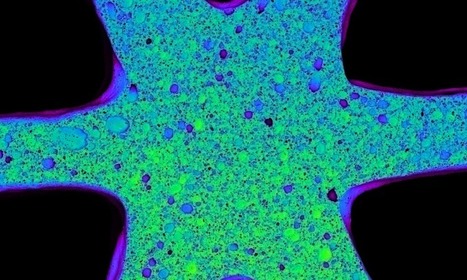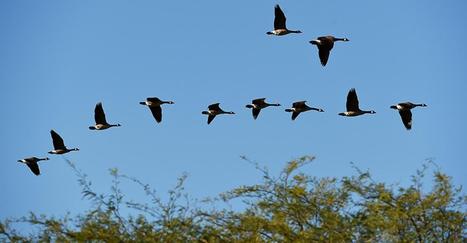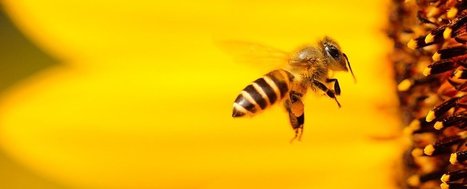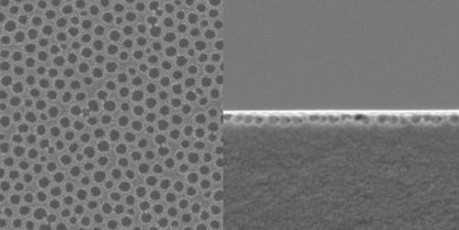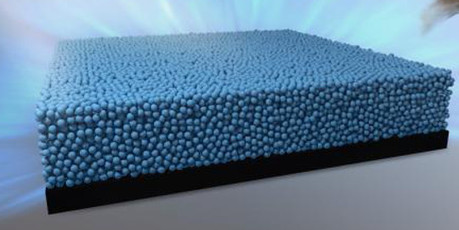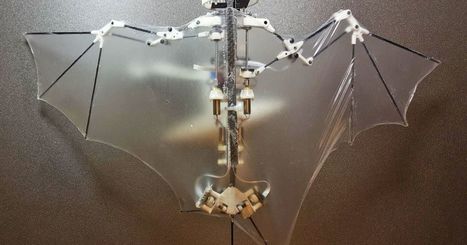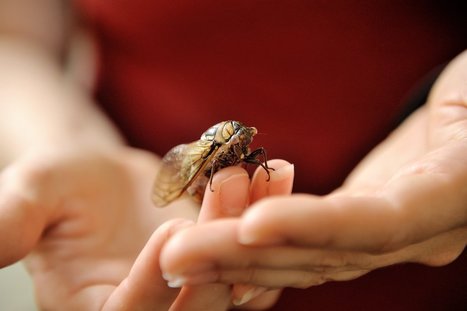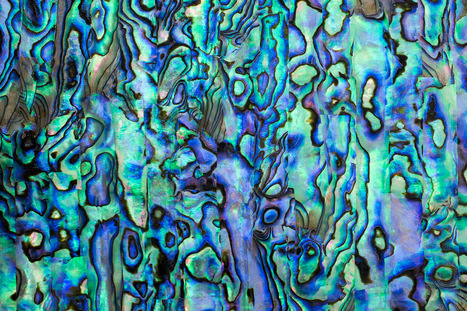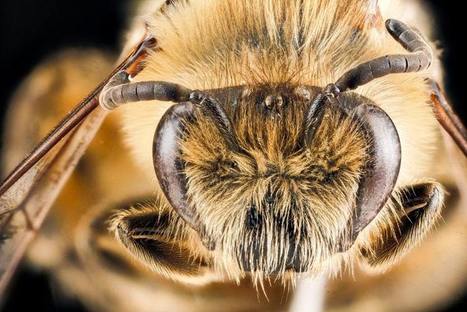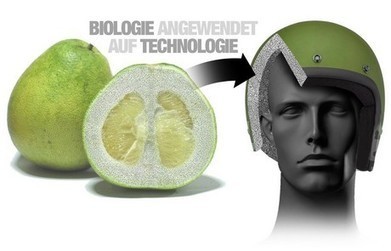 Your new post is loading...
 Your new post is loading...
"[...] a team of Danish researchers has designed a surprisingly “organic” model for the inside of an airplane wing by harnessing the immense computing power of 8,000 CPUs. In a letter published in Nature, Niels Aage and colleagues from the University of Denmark showed off an intricately curved and fractal-like airfoil design that’s strikingly similar to the interior of a bird’s wing and beak."
"Nature does amazing things with limited design materials. Grass, for example, can support its own weight, resist strong wind loads, and recover after being compressed. The plant's hardiness comes from a combination of its hollow, tubular macrostructure and porous microstructure. These architectural features work together to give grass its robust mechanical properties. Inspired by natural cellular structures, researchers at the Harvard John A. Paulson School of Engineering and Applied Sciences (SEAS), the Wyss Institute for Biologically Inspired Engineering at Harvard University, and MIT have developed a new method to 3D print materials with independently tunable macro-and microscale porosity using a ceramic foam ink."
"Boeing Co. and NASA have found an inexpensive way to cut airline fuel bills by borrowing a trick from the world’s greatest long-distance aviators: migratory birds. By lining up cruising aircraft in a V-shaped formation favored by Canada geese, carriers would be able to produce a leap in efficiency without investing in structural makeovers or futuristic technology. The idea is to link the flying convoys safely using navigation and collision-avoidance tools that already are widely installed in cockpits."
Researchers at Purdue University, West Lafayette, have developed a new technology called “organismoids”, devices created from a ceramic material that mirror animal memory by learning to forget unimportant memories while retaining important ones.
"Spider silk properties continue to amaze and astound, the more we learn. They are lightweight, and yet one of the toughest natural materials. They are virtually invisible to the human immune system, making spider silk a natural material for medical uses. Mankind already puts the magical threads to use, in applications as varied as weaving a golden cloak from natural spider silk to making dissolving tennis shoes out of a material invented while trying to mimic spider silk. But it could get much better. Scientists at the Perelman School of Medicine at the University of Pennsylvania have sequenced the entire genome of the golden orb spider, one of the most productive of all spiders."
"New research on how bees perceive colour could be put to good use in our digital cameras, meaning photos shot by drones or phones would look more natural than ever. It's all to do with colour constancy, the way that bees (and humans) can tell a flower is red no matter what the colour or quality of the light – a mental trick that the digital cameras of today really struggle with."
"Ribbon halfbeak are a species of fish with the ability to fly above the sea surface - but unlike true 'flying fish', they lack the necessary hind wing fins. So how do they fly? Dr Yoshinobu Inada from Tokai University, Japan says, "Investigating the design of ribbon halfbeak could provide useful information for the optimal design of tandem wing airplanes."
Screens on even the newest phones and tablets can be hard to read outside in bright sunlight. Inspired by the nanostructures found on moth eyes, researchers led by Shin-Tson Wu of the University of Central Florida have developed a new antireflection film that could keep people from having to run to the shade to look at their mobile devices. The antireflection film exhibits a surface reflection of just 0.23 percent, much lower than the surface reflection of usual phones of 4.4 percent.
"Using a mathematical model and the mackerel pectoral fin as an illustrative example, [...] researchers show how fin stiffness may be changed by applying a u-shaped curvature at the fin's base. The effect, the researchers say, might underlie the ability of fish to swim at widely varying speeds in all kinds of currents with great maneuverability. [...] The researchers say their model suggests intriguing possibilities for the design of robotic swimmers."
"Bright colors in the natural world often result from tiny structures in feathers or wings that change the way light behaves when it’s reflected. This structural color is responsible for the vivid hues of birds and butterflies. Artificially harnessing this effect could allow us to engineer new materials for applications such as solar cells and chameleon-like adaptive camouflage. Inspired by the deep blue coloration of a native North American bird, Stellar’s jay, a team at Nagoya University reproduced the color in their lab, giving rise to a new type of artificial pigment. “The Stellar’s jay’s feathers provide an excellent example of angle-independent structural color,” says Yukikazu Takeoka, “This color is enhanced by dark materials, which in this case can be attributed to black melanin particles in the feathers.”
"The habits and anatomy of birds are being used by boffins at Airbus to develop quieter and more fuel efficient planes. The aviation giant, which makes and designs wings in Broughton, Flintshire, and Filton, Gloucestershire, employs Professor Norman Wood to unlock the mysteries of the natural world to help gain a commercial advantage.
It is using so-called ‘biomimicry’ in the design of intelligent wings that react automatically to the environment, just as an eagle’s or a peregrine falcon’s do."
"This robotic bee drone prototype gives bees a hand in pollinating flowers and could be a solution to the dwindling bee population. [...] Part-awareness rising project, part-potential solution to a very real problem, Plan Bee is a self sustainable drone that stimulates the growth of plants by cross-pollination. The drone sucks pollen through tiny holes located underneath and then pushes it back out through the vents on top. As the drone flies over the field, the pollen will fall on the flowers nearby. The device is also equipped with a UV camera to locate the flowers."
"Robotic birds and winged insects are relatively easy to create, but with over 40 joints in their wings, bats offer a new level of intricacy. Or, as Caltech professor and Jet Propulsion Laboratory researcher Soon-Jo Chung put it during a press conference, "bat flight is the holy grail of aerial robotics. [...] By simplifying that wing structure into just nine key joints covered by a flexible membrane, however, the team successfully created the first Bat Bot. Built from carbon fiber bones and 3D-printed socket joints, Bat Bot weighs just 93 grams and the silicon-based wing membrane is only 56 microns thick with a roughly one-foot wingspan."
|
Scientists at the USA’s Stanford University have looked at the eyes of insects to create the newest form of solar cells. They have discovered that packing tiny solar cells together could pave the way for a new generation of advanced photovoltaics.
A team of researchers from China and the U.S. has created a robot that is able to mimic a remora fish by adhering quickly and strongly to underwater objects.
"[...]Earth’s biosphere has about 3.8 billion years of design experience at managing its rainfall. Compared with the typically impervious urban environment, where about 80 percent of rainfall becomes runoff, in a healthy Northwest forest, just 0.2 percent of rainfall does.
"Researchers are looking to insects – specifically cicadas – for insight into the design of artificial surfaces with de-icing, self-cleaning and anti-fogging abilities. Their wings allow cicadas to fly, of course, but they also are good at repelling water – a condition that humans can appreciate, too."
"It’s a technicolour dreamcoat for your crisp packet – a strong, flame-retardant and airtight new material that mimics mother of pearl. The natural version, also called nacre, is found on the inner shell of some molluscs, where it is built up of layers of the mineral aragonite separated by organic polymers such as chitin. It is remarkably strong, without being brittle or dense. We would like to use nacre and similar materials as a protective coating in many situations."
One area where biomimicry is yielding fascinating results is in the field of optics and machine vision. While our cameras and ways of thinking about sight have largely been informed by the human visual system, cutting-edge research is looking to insects to find new tricks for everything from depth perception to colour analysis.
The spatial distribution of fibers in hollow bamboo cylinders is optimized to reinforce flexural rigidity, a new finding that sheds light on biomimetic approaches in the development of materials.
Light and tough, bamboo is widely used as a natural, functional material in Japan and other Asian countries. Bamboo is light because of its hollow structure, which allows the plant to grow faster with small amounts of woody parts and expose itself to sunlight above other trees.
"The pomelo is a large citrus fruit, somewhat like a grapefruit, and the structure of its thick rind provides great impact protection when the fruit falls off the tree. BMW, along with a group of German companies and universities, have taken inspiration from nature’s design for new protective gear as part of the Bio-Inspired Safety Systems project. The pomelo’s rind is especially good at impact absorption because it is an auxetic material. This means that when the stuff stretches the substance becomes thicker."
Kazuya Saito (University of Tokyo) and colleagues used high-speed video to watch a ladybird fold its wings. “They found that prominent veins along the edge of the wings allow creases to form and fold the wings away in a complex, origami-like shape. A bend in the wing can drift down a vein as it gets folded, but the wing is ready to spring back to a rigid form when the elytra [i.e. wing cases] open”, New Scientist explains. The wing frames do not have any joints. The NS article also suggests a biomimicry dimension. This “folding mechanism could help us build solar array paddles that unfold themselves in space, foldable wings for small vehicles, or even lead to better umbrellas.”
"Researchers from the University of Granada (UGR) have designed an algorithm, inspired by the intelligent and social behavior of bee colonies, which allows law enforcement to attack and dismantle any type of social network that poses a threat, whether physical or virtual, such as social networks linked to organized crime and jihadist terrorism."
"From a whale shark keeping unwanted freeloaders off its skin to water droplets rolling off a duck’s feathers, nature has many ingenious ways of keeping surfaces clean. The science of biomimicry, or biomimetics, seeks to harness nature’s cleverest capabilities which have taken aeons to evolve. Scientists at AkzoNobel, a global paints and coatings company, are using principles derived from nature to develop coatings that protect surfaces such as the hulls of cargo ships. And other heavy industries such as rail are experimenting with biomimicry."
"Our data-driven society is churning out more information than traditional storage technology can handle, so scientists are looking for a solution in Nature's hard drive: DNA. A pair of researchers at Columbia University and the New York Genome Center recently wrote a full computer operating system, an 1895 French film, an Amazon gift card and other files into DNA strands and retrieved them without errors, according to a study published in the latest edition of Science."
|

 Your new post is loading...
Your new post is loading...
 Your new post is loading...
Your new post is loading...





